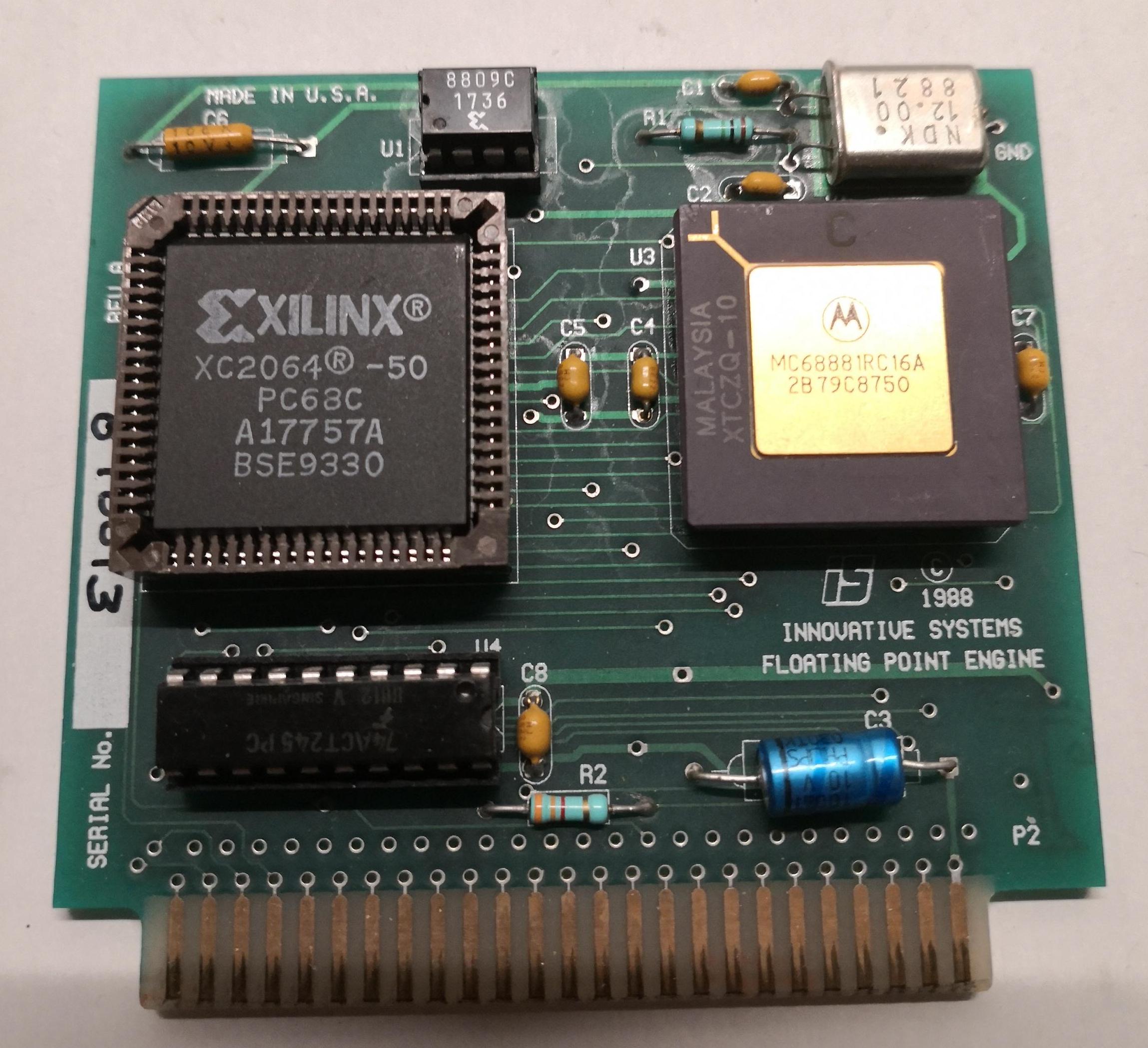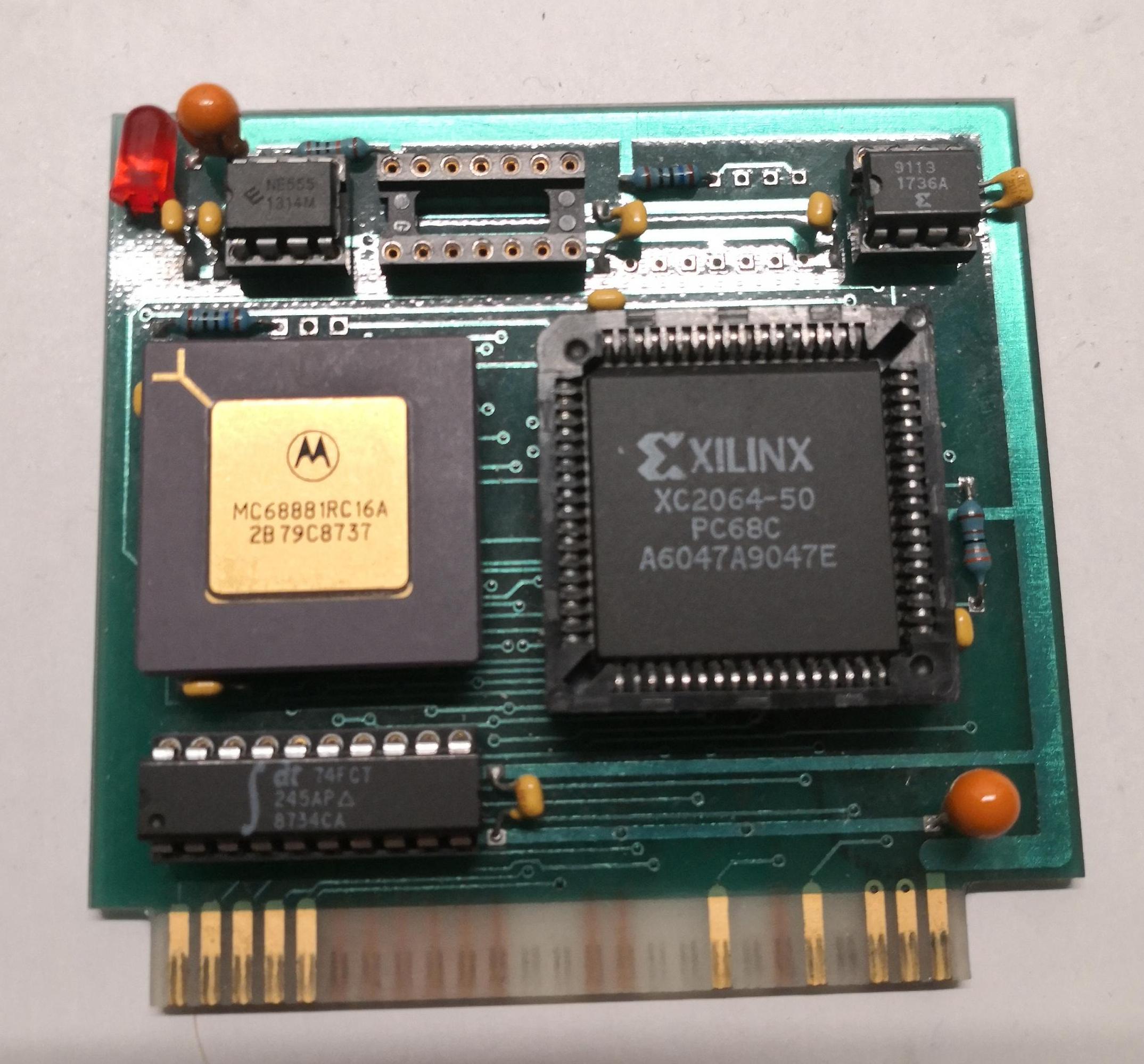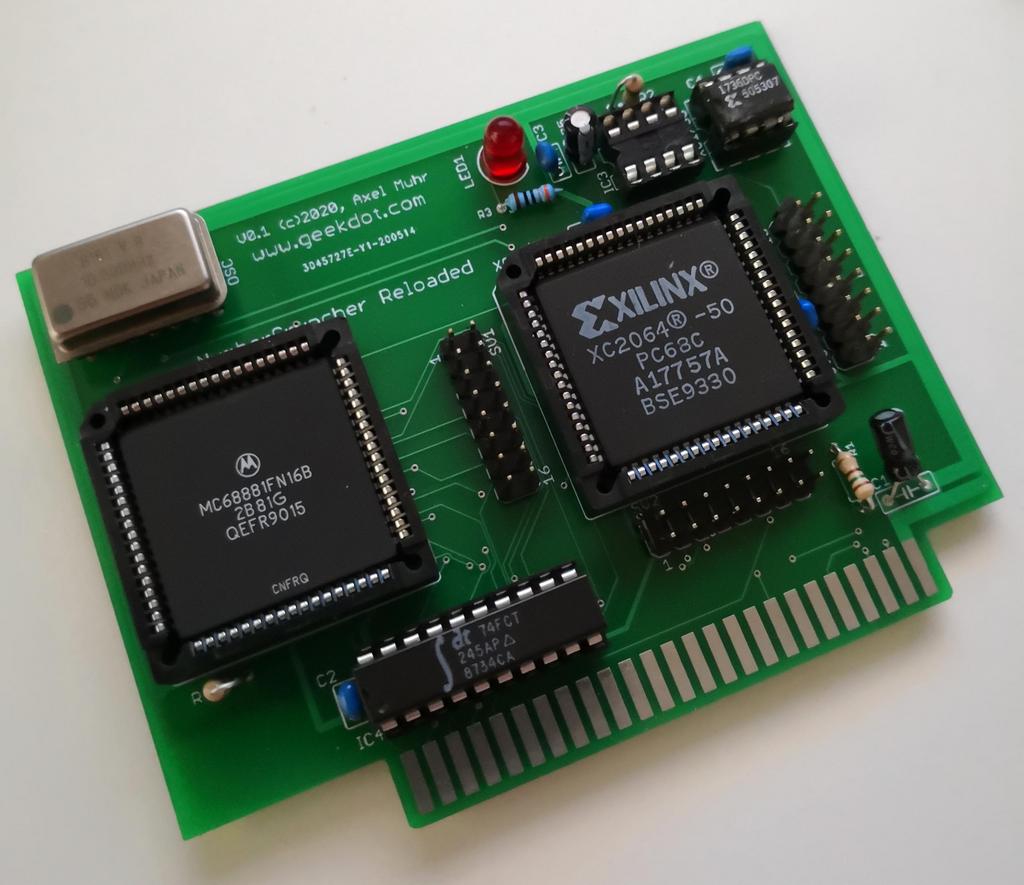This is a post I’d like to write since 2006… so 15 years after I’ve put all the Transputer, MIPS, i860 and-what-not stuff aside and made some room for my other (late) love: The Apple IIgs
You might have stumbled about my post/project connecting a Transputer to the Apple II called the T2A2… well, what I did not mention was, that the inspiration to this came from another card built in 1988, called the FPE made by Innovative Systems. That’s a small card featuring just a buffer, an old XILINX FPGA (actually the first of its kind) and the Motorola 68881 floating point co-processor.
Co-pro-ces-sor! I was hooked! 😯
After more research I learned that the FPE was actually a diva like this newsgroup post says:
“The FPE is suffering from a major problem, namely the coproc is crashing internally and has to be reset in software. This happens in a non deterministic way, and software written for that engineering junk must be adapted to that. “
But a bit later there was something better available: The Number Cruncher (NC for short). Fine German engineering 😉 And the newsgroup post was quite nice to it:
“The Number Cruncher is compatible with the FPE but is actually what the FPE was supposed to be – a math coproc that works. It perfoms very well.”
This is the “marketing blurb” from back then
- totally compatible with the FPE from Innovative Systems
- much less sensible to heat, voltage problems etc.
- supports the FPE SANE patch for speeding up any program that does floating point calculations
- you can compile ORCA/Pascal and C programs to use it directly with the special floatlib for the FPE provided by The Byte Works
- works in any slot (slot 3 & 4 without need for setting it to “Your Card”)
- works with TransWarp GS and Zip GS accelerators and RamFAST SCSI card
- comes with lots of mathematical software and an enhanced SANE patch by Albert Chin-A-Young
I directly contacted the creators of the NC, Dirk and Andreas, but both of them hadn’t had a tiny bit of the NC left. No schematic, no HDL, no nothing 🙁
During looooong and wild eBay raids I managed to get my hands onto an FPE as well as on an NumberCruncher. Woohoo! They both work with the same driver and yes, the NC is much more robust than the FPE.
But it seems that there are only a handful of them survived, if anymore at all. So I thought it might be interesting for me and others to make a re-release…
Let’s re-animate the Number Cruncher!
So, again, it’s up to me to save the world… reverse-engineering time again!
This job consists of two parts – dissect the hardware and to get a better understanding of this, the software/driver, too.
Hardware
Well, you could simply rebuild the card, copy the bitstream from the serial PROM for the FPGA and you’re done.
But it’s not so easy, as the FPGA which has been used, the XILINX XC2064 is long time EOL’ed and if you buy old stock, they’re more expensive than a comparably recent CPLD – if they’re not Chinese fakes and/or broken… not mentioning that a simple copy-paste job is not really manly 😉
The XC2064 is a 5V FPGA (the first of its kind actually), has 600-1000 logical gates and 58 user IO pins of which 32 are used. It is getting its bitstream fed by an external 12K serial PROM. I’ve pulled the bitstream in a file available here, but because XILINX never documented that format, it’s pretty much useless.
The rest is all standard stuff. A ‘245 transceiver, an oscillator (~12MHz) and some chicken feed.
Revving it up
To prove that I got everything right and having a better attack analysis vector I designed the “NumberCruncher Reloaded v0.1“… more or less a 1:1 clone but bringing out all FPGA signals to pin-headers to have a convenient access for my logic analyzer.
Also I used a PLCC version of the 68881, because I have more of those.
Then, out went the logic analyzer and weeks and weeks of looking/listening to the the FPGAs conversation to the the FPU and Apple bus while having the 68881 manual on my lap, I got an idea of what’s going on.
Software
Later I found the original floppy which came with the NumberCruncher containing just the init-files for GS/OS patching SANE to use the FPU instead of the 65c816 (download the ShrinkIt archive here) – well, at least something!
Next came my ol’ buddy Mr. disassembler… a lot. About a year on-and-off… and here’s my initial, slightly commented disassembly of the SANE patch.
Again, some years down the road I found the floppies which were delivered with the FPE and those are quite helpful with code examples, assembler macros and libs etc. – that would have been quite helpful during the disassembly 😕 Anyhow, it’s good to see that most of my interpretations were correct.
Also, the FPE came with quite a nice manual – which actually was more valuable than the card 😉
It very well describes the basic functionality, the FPU registers used and the programming side of things – even the most important parts from the 68881 manual are cited. Very good job on that Innovative Systems!
Having all this at my hands I was prepared to start and after some huffing and puffing the NumberCruncher Reloaded v.1.0 was born.





Amazing. I would’ve killed for a FPE or a NC back in the late 80’s to ’96 when I was doing floating-point intensive stuff on my IIgs.
Hi Axel,
you are showing the NumberCruncher without an oscillator….
You have indeed posted a PROM file from the NumberCruncher and NOT from the FPE….
Have you ever looked into the PROM file?
cul8r, AS
Yes, the NC does not have its 12MHz bog-standard oscillator fit on this picture… but he took it like a man 😉
And yes, I looked at the bitstream of the FPE and it is as encrypted/undocumented as the one of the NC… the XILIX XC20xx bitstreams are more or less still a black-hole even some brave souls are working on reversing them.
So in the end, both bitstreams won’t help you much except you’re doing an exact copy of one of the PCBs. Which I did in the first place for the NC to get a better understanding of the signals going in and out of the XC2064.